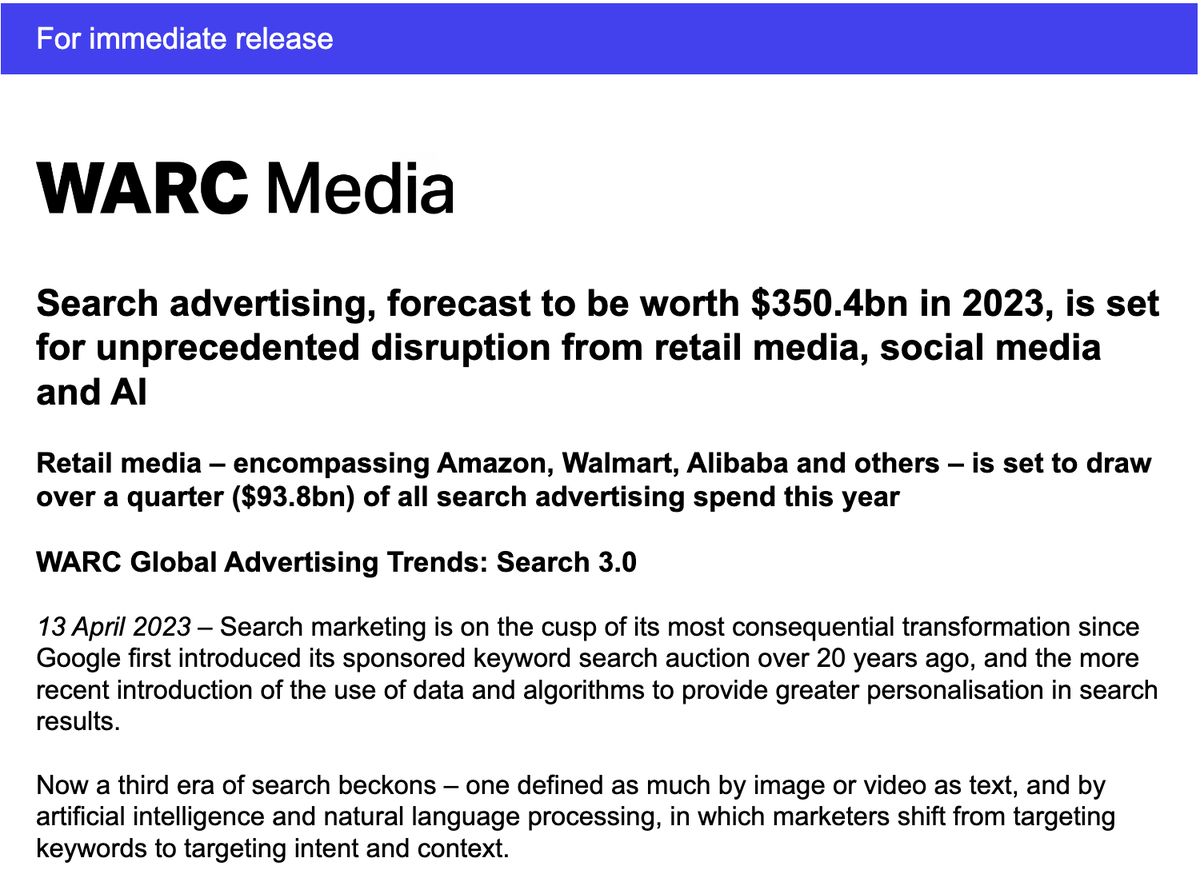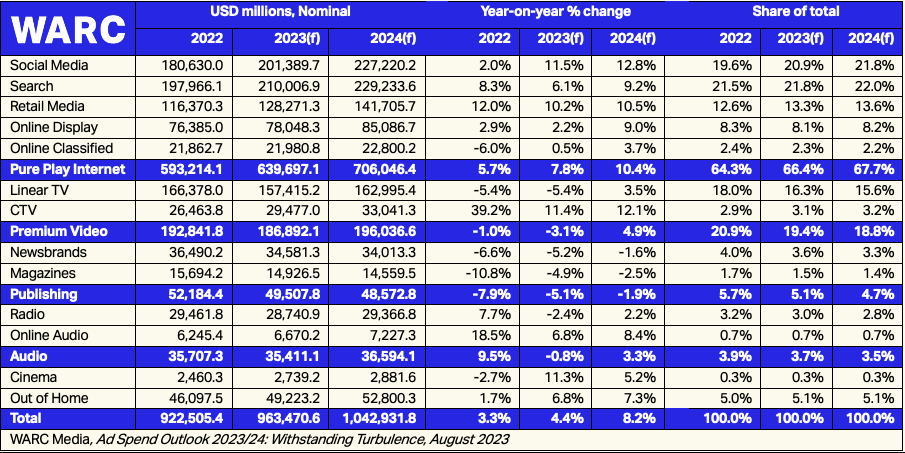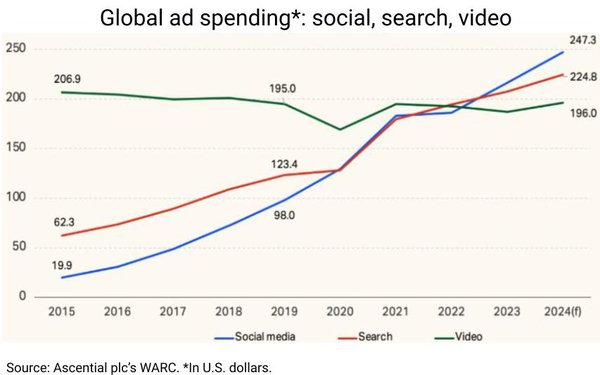Commentary
Is Social Now The Largest Ad Channel -- Depends On Who You Talk To
- by Joe Mandese @mp_joemandese, May 2, 2024

I miss the days when McCann-Erickson’s Bob Coen
was the default – if not the sole – ad industry bean-counter. It made life easier for an advertising trade journalist trying to understand -- and bucket -- shares of ad spending by
medium.
While I didn’t always agree with the late Coen’s categorizations, at least they were an industry standard for benchmarking the ebb and flow of ad demand by medium.
Fast-forward to today, and four of the major holding companies -- Dentsu, Publicis’ Zenith, WPP’s GroupM, and Coen’s descendants at IPG Mediabrands’ Magna -- each have their own way of categorizing and calculating things.
Then add in a variety of third parties ranging from financial-sector analysts, to pure-play ad industry researchers like PQ Media, Brian Wieser’s Madison and Wall and Ascential plc’s WARC, and you’ve got quite a varied mix of apples and oranges.
advertisement
advertisement
That's one of the reasons MediaPost periodically publishes an industry composite of Madison Avenue's Big 4 forecasting units based on percent changes, but not absolute totals by medium.
Because, well, there is no consensus on many of the medium line items calculated in their totals.
I mean, what else can an ad-trade journalist -- much less a practicing media planner or buyer -- do? Well, if you receive a press release, as I did this morning, touting the headline above, you have to drill down into it.
"Social media is now the largest channel worldwide by advertising investment, forecast to reach $247.3 billion in 2024," read the subject line of the press release I received this morning from WARC touting the tipping point.
That WARC release, ironically seems to contradict one sent exactly one year ago touting that search, not social, was the largest ad channel -- by about $100 billion over social -- in the global media mix (see below).

I'm not sure what led to WARC's change of heart, or calculations since last
year, but it's also out of whack with an updated global forecast WARC published a couple of months later in August 2023 (see below), which still showed search -- albeit a decidedly smaller estimate
for that category -- as the dominant "ad channel" vs. social. Though not by much.

“Much of social media’s success has been driven by Meta’s remarkable renaissance," WARC Head of Content Alex Brownsell states in today's social dominance release, adding, "However, social’s stronghold on budgets can also be seen in TikTok’s rise, and a return to double digit ad revenue growth at Snapchat and Pinterest."
I'll spare you the statement Brownsell issued in last year's WARC search dominance report, but you get the drift.
Look, I'm not saying things don't change in the ad forecasting biz, nor that they don't change rapidly, but I am saying it has something to do with how you categorize things. Which is why I always admired -- and tried to cover -- GroupM's now defunct "This Week, Next Week" podcast, in which former GroupM-er Wieser and current business intelligence chief Kate Scott-Dawkins, frequently opened their kimono and explained how they were rethinking and revising line items to reflect changes in the market that contributed to their underlying numbers.
By the way, I offered for MediaPost to host a re-launched version of that podcast if GroupM ever wanted to, and I'm offering the same deal to anyone else who wants to speak regularly on this topic. It need not be weekly, but we can figure out the frequency based on what makes sense.
In the meantime, I tried digging through the Big 4's most recent global ad forecasts to see if I could put an agency holding company perspective on WARC's breaking social dominance news today.
Interestingly, the only one that has discrete search and social line items published for comparison is Magna, whose most recent global forecast gives social a 22.2% share of global ad spending, a distant second to search's 35.6% share.
"Keyword Search remains the most popular ad format, approaching the $300 billion milestone this year (+9% to $298 billion)," Magna stated in December, noting, "Social media owners (e.g., Meta, Tiktok) re-accelerate (+15% to $182 billion), while short-form pure-play video platforms (e.g., Youtube, Twitch) grow by +9% to $70 billion."
So there you have it.
I miss Bob Coen.





Joe, I wouldn't be surprised to see one of these sources breaking out "programmatic" as a "channel" even though it's nothing more than a computerized media selling/buying system---not a media audience venue.
Good post Joe.
I like that old saying that the most accurate forecast is that forecast is rarely accurate.
I agree Joe that life was much easier back in the 1990s when Bob Coen would get up at an annual analyst meeting in December to announce his ad spending data. For me as head of research & publications at Veronis Suhler Stevenson (VSS) and editor of its annual "Communications Industry Forecast" (CIF), it was the benchmark I used to start the five-month process of preparing the CIF. Today's new flavor-of-the-month, retail advertising, is just a new name for the retail channels in the marketing services sector, such as consumer promptions, that was covered by VSS in the CIF from 1989 to 2012, and is found since 2013 in the PQ Media Global Advertising & Marketing Forecast (GAMF). Joe, every year when we prepare the GAMF, we struggle with the advertising & marketing hierachy as to where to put certain ad & marketing data. For example, we struggle as to when a marketing spend should be placed in the channel of product placement versus content marketing; and conversely when another marketing message is influencer marketing versus podcast advertising, streaming video advertising or social media advertising. And Ed, I agree that programmatic is not an ad channel, but a selling/buying system. FYI Joe, PQ Media has search as a marketing channel, not advertising, and it's larger than social media advertising. In 2023, search accounted for 8% and social media for a 5% share of the $1.630 trillion spent on worldwide advertising & marketing. In the U.S. its 9.3% & 4.7%, respectively, of $645 billion.
Great comment and summary Leo. Many thanks.
As a follow up to my previous comment, one of the reasons that there are so many different data figures for the same data category is that most trade organizations have stopped using independent auditors of their members. Back in the 1990s and early 2000s when I worked on the CIF I would get PUBLIC data from the TVB (broadcast TV), CAB (cable TV), IAB (Internet), OAAA (out-of=home), CAC (cinema), NAA (newspapers), MPA (consumer magazines), BIN (B2B mags), DMA (direct marketing), PRC (public relations), IEG (event sponsorships), INMAR (coupons), PPAI (promotion products), and POPAI (point-of-purchase). Magazines covering the industry, like "Promo," "Editor & Publisher" "Folio" and "Tradeshow Week" were other great sources for spend data. Today, only the TVB, IAB, and OAAA put out this data annually (and sometimes quarterly).
Very true Leo.
In AU we (in the main) define specifications of what each medium wants and/or needs. That is put to the research market and assessed by a panel of specialists (media owners, media agencies and also input from advertisers) to select the best options and then the costs are assessed to decide the winner. The costs are then shared amongst the subscribers reflecting their incomes. The macro data is generally circulated in the main media for public use, but the micro data only goes to the subscribers which is analysed client by client, brand by brand etc.
The missing thing that we all want is a single universal measurement of all media. My belief is you can't measure all media and media users in a single shot. For a couple of decades we have been using modelling to produce guidelines of what the most efficacious combination was for a category, or a brand, or a location, or a price.